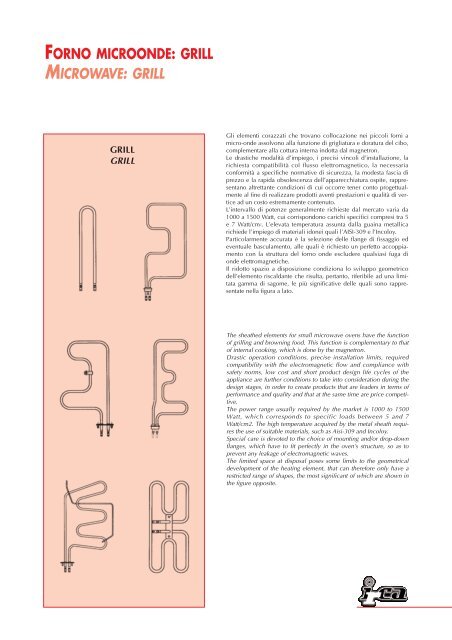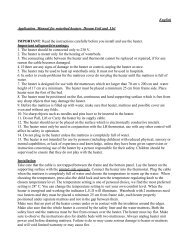Catalogo
Catalogo
Catalogo
You also want an ePaper? Increase the reach of your titles
YUMPU automatically turns print PDFs into web optimized ePapers that Google loves.
FORNO MICROONDE: GRILL<br />
MICROWAVE: GRILL<br />
GRILL<br />
GRILL<br />
Gli elementi corazzati che trovano collocazione nei piccoli forni a<br />
micro-onde assolvono alla funzione di grigliatura e doratura del cibo,<br />
complementare alla cottura interna indotta dal magnetron.<br />
Le drastiche modalità d’impiego, i precisi vincoli d’installazione, la<br />
richiesta compatibilità col flusso elettromagnetico, la necessaria<br />
conformità a specifiche normative di sicurezza, la modesta fascia di<br />
prezzo e la rapida obsolescenza dell’apparecchiatura ospite, rappresentano<br />
altrettante condizioni di cui occorre tener conto progettualmente<br />
al fine di realizzare prodotti aventi prestazioni e qualità di vertice<br />
ad un costo estremamente contenuto.<br />
L’intervallo di potenze generalmente richieste dal mercato varia da<br />
1000 a 1500 Watt, cui corrispondono carichi specifici compresi tra 5<br />
e 7 Watt/cm 2. L’elevata temperatura assunta dalla guaina metallica<br />
richiede l’impiego di materiali idonei quali l’AISI-309 e l’Incoloy.<br />
Particolarmente accurata è la selezione delle flange di fissaggio ed<br />
eventuale basculamento, alle quali è richiesto un perfetto accoppiamento<br />
con la struttura del forno onde escludere qualsiasi fuga di<br />
onde elettromagnetiche.<br />
Il ridotto spazio a disposizione condiziona lo sviluppo geometrico<br />
dell’elemento riscaldante che risulta, pertanto, riferibile ad una limitata<br />
gamma di sagome, le più significative delle quali sono rappresentate<br />
nella figura a lato.<br />
The sheathed elements for small microwave ovens have the function<br />
of grilling and browning food. This function is complementary to that<br />
of internal cooking, which is done by the magnetron.<br />
Drastic operation conditions, precise installation limits, required<br />
compatibility with the electromagnetic flow and compliance with<br />
safety norms, low cost and short product design life cycles of the<br />
appliance are further conditions to take into consideration during the<br />
design stages, in order to create products that are leaders in terms of<br />
performance and quality and that at the same time are price competitive.<br />
The power range usually required by the market is 1000 to 1500<br />
Watt, which corresponds to specific loads between 5 and 7<br />
Watt/cm2. The high temperature acquired by the metal sheath requires<br />
the use of suitable materials, such as Aisi-309 and Incoloy.<br />
Special care is devoted to the choice of mounting and/or drop-down<br />
flanges, which have to fit perfectly in the oven’s structure, so as to<br />
prevent any leakage of electromagnetic waves.<br />
The limited space at disposal poses some limits to the geometrical<br />
development of the heating element, that can therefore only have a<br />
restricted range of shapes, the most significant of which are shown in<br />
the figure opposite.



